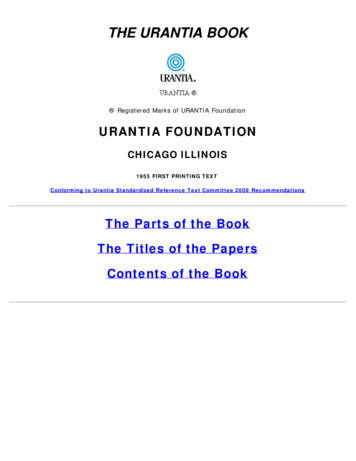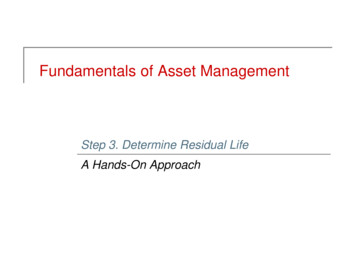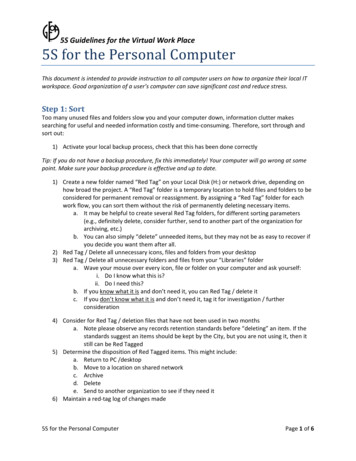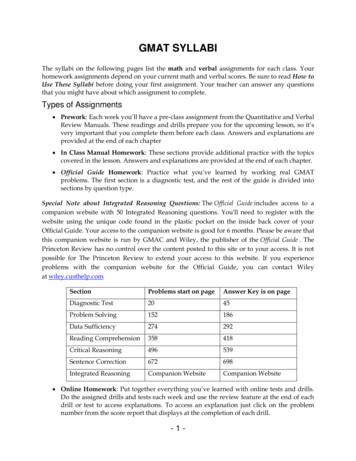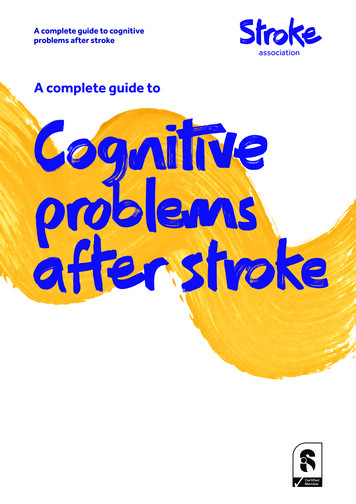
Transcription
CommentariesOnLife’s ProblemsAndThe Psychic Powers of ChristJohn Cuffe2010
2
3CONTENTSList of Illustrations and Tables5General Introduction7Life’s Problems11The Psychic Powers of Christ139The Seeking of J.S.M. Ward; A Summary303Teachings of J.S.M. Ward and his Followers308The Major Works of J.S.M.Ward309
4
5List of Illustrations and TablesThe Holy Spirit or The Divine MotherThe Various Planes of ExistencePAGE2235John & Jessie Ward and their Community during the 1930’s152Apocryphal Accounts of the Birth of Christ Compared192Apocryphal Accounts of the Birth of Christ Compared (cont.)194Adult Female Showing form of Aura279Adult Male Showing form of Aura279
6
7General IntroductionBoth “Life’s Problems” and “The Psychic Powers of Christ” were written by John SebastianMarlow Ward after he had begun his Work in preparation for the Coming of Christ the Kingand as such represent his considered opinions on the subjects they present. Both works werepublished for use in the broader community and both epitomized some of the teachings thatwere to form the basis of the New Age Theology that he proclaimed to the world as anintegral part of that Work. For make no mistake about it, Ward always saw his primary task aspreparing the way for the Coming of Christ the King, and all the other wisdom that he offersto the world was seen by him, at least partly as a means of helping his followers to promoteknowledge of that main fact. He saw himself playing much the same role in the last years ofthe Christian Era, as St John the Baptist in the ending of the Jewish Dispensation, or rather,perhaps, like the unnamed founder1 of the Essene movement a century or more before thebirth of Jesus of Nazareth.In Ward’s day most of the little that was then known about the Essenes was derived from thewritings of the Jewish historian, Josephus and Hellenised Jewish philosopher, Philo. It wasknown to have derived from a decision by the Jewish Sanhedrin in 140BC to transfer the HighPriesthood to the chief of the Macchabees2 and thus established the Jewish Hasmonaeandynasty of kings. For more than 800 years before that date, since it was granted by KingSolomon to Zadok the priest who had anointed him king, it had been held by his descendants,and is thus known to history as the Zadokite priesthood.After this decision the defeated party in the Sanhedrin, who continued to support theZadokites, withdrew into Egypt and the deserts of Judea, where their leaders established twoseparate but related organisations. The first, under the old Zadokite High Priest, Onias IV,1Generally called simply the Teacher of Righteousness, this enigmatic figure is also sometimesidentified with Yeheshua ben Sirach, who is believed to have been the author of the apocryphalbook of “Wisdom”, early in the 2nd century BC. This book, which was preserved for posteritythrough the actions of his grandson, about sixty years later, never made it into the Jewish Bible,but was accepted as canonical by the Roman Church in the 16th century AD. Perhaps some ofWard’s writings will similarly be preserved far into the New Age that is even now beginning todevelop on earth.2The Macchabees were led by Judas Macchabaeus and the other sons of a minor Jewish priestnamed Asmonaeus, from whom his descendants are called the Hasmonaeans. It was they who ledthe revolt of the Jews against the Syrian king Antiochus Epiphanes. He had previously expelledthe true Zadokite High Priest, Onias IV, from Jerusalem, causing him to flee to Egypt where hepersuaded the Egyptian authorities to allow him to build another Temple at Leontopolis.Antiochus installed his own choice of High Priest, and together they defiled the Temple atJerusalem by sacrificing swine thereon and re-dedicated it to the Greek God, Zeus. (164 BC)Antiochus had also forbidden the Jews to practise any other part of their religion, and sent hissoldiers around the country to enforce this law. Asmonaeus, aided by his sons, slew his emissariesand thus started the rebellion of the Macchabees, which first restored the Temple (161 BC) andeventually led to Jewish independence. Although Judas himself was killed in the fighting theHasmonaean dynasty of priest-kings was started by his brother Simon.
8built their own Temple at Leontopolis3 in the Nile Delta, which continued to be serviced bythe Zadokite priesthood for another two centuries, and in fact outlasted the Temple atJerusalem4. Many of them established desert communities living a devout religious life, andPhilo calls them the “Therapeutae”.The second group, also retaining the Zadokite priesthood, and although regularly persecutedby the Temple authorities in Jerusalem, remained within the borders of Israel, but built theirown religious centre in the Judean desert near the Dead Sea at a place called Qumran. Theytoo, established communities in the uninhabited parts of the country, where according toJosephus they were known as Essenes. He also tells us much of the little that was knownabout them in Ward’s day.Apparently they were widely respected by the general populace because of their piety andtheir ability to prophesy and they devoted themselves especially to the task of preparing theway for the coming of the Messiah. Based on St Luke 1; 80; it is widely considered that StJohn the Baptist spent most of his early life among the Essenes, and certainly his message waswholly consistent with theirs.The Therapeutae and the Essenes had much in common, in both cases, their devotees lived incommunities far from the cities, but they also had widespread support among the commonpeople of the towns, though not, of course, the Temple authorities in Jerusalem. Apart fromthis, little was known about either group in Ward’s day, and both would perhaps haveremained equally unknown but for the discovery in 1947 to 19525 of what scholars have sincerecognised to have been part of the library of Qumran, hidden in large, stoppered, pottery jars,in a series of caves near the Dead SeaNow popularly known as the Dead Sea Scrolls, these have provided us with a fairly detailedinsight into the life and teachings of the Essenes. They include the oldest known copies ofmost of the books of the Old Testament as well as other writings of the sect, including therules by which members should live, and numerous known and previously unknown Jewish3It is generally considered that this Temple was probably built over several years and finishedbetween 150BC and 145BC shortly before the Jewish Sanhedrin made its fateful decision.However, this should not surprise us, for the Council decision only formalised and madepermanent a position that the Jewish people had adopted in practice at least twenty years earlier,when the Macchabees became the defacto rulers of the people.4It did outlast it, but not by much. After the Romans destroyed the Temple at Jerusalem in 70 ADJewish resistance continued for another three years before the last rebel-held Judean fortress,Masada, was finally taken. The Jews in Egypt who had taken no overt part in the rebellioncontinued to worship at their own Temple in Leontopolis until 73AD, when by orders of theRoman authorities, it was permanently closed5There were a number of different discoveries over this period. The first, in 1947 was made byunlettered Beduin Arabs, who in some cases actually used the scrolls to help light their camp firesand it is not known how many scolls were lost in this way. Others were sold in local markets, andit was as a consequence of these sales that the discovery first came to the notice of scholars. Manywere recovered from private purchasers, and a systematic search of the areas was begun, whichyielded a number of other finds in other caves during subsequent years. Whethr or not Ward hadheard of the first discovery before he died in 1949, it is certain that none of the informationcontained in the scrolls was available until many years after his death.
9pseudepigraphical works. The latter includes a rather unusual scroll, called “The Coming ofMelchizedek” which sees the coming Messiah as the return of the Ancient Priest-King and theending of the Age as being the grand fulfillment of God’s purpose for Israel, rather like theJewish Jubilee Year6Unlike some of Ward’s earlier works, these two books were both written with the intentionthat they should play a part in the education of the members of his community at Barnet.Therefore, the commentaries that I have provided, are perhaps a little less extensive than withthose attached to some of his other works. Nevertheless, they are still considerable, for thereare still passages whose meaning is a little obscure, sometimes because of Ward’s archaiclanguage and phraseology, but also at times because modern discoveries have providedadditional information on some of the subjects that he addresses. Again, occasionally it hasseemed necessary to expand somewhat on his work at some point in the text, though oftenonly to bring to the attention of the reader facts of which Ward was well aware, and whichsometimes he himself adduces upon re-visiting the subject at a later stage.For better or for worse, these comments are offered to the earnest Seeker, together with thewritings of Ward himself which are deliberately in a form that is as close to the original aspractical. May he, in his higher State of Being, overshadow the reader and may the King ofKings, for Whose Coming we prepare, Himself deign to accept the offering of this workwhich we humbly present for use in His Service.John Cuffe2010.6Under the Law of Moses, after seven sevens of years, the fiftieth year was to be kept as a Jubileeyear, (Leviticus 25 8 – 11) in which things were “made new” and many aspects of Jewish lawcentred on this concept. Ancestral lands could only be sold “until the Jubilee year”, with the pricedetermined by the length of time remaining (verses 15 – 16) At that point in time they were torevert to the original owner. Individuals could only be sold into slavery until the Jubilee year,(verses 50 – 55) at which point they were to be freed. Thus, it was predicted, it would be in theGreat Jubilee of Melchizedek. This idea finds its reflection in Revelation 215, in which Christ,when He sits in Judgement, says; “Behold, I make all things new.’Both concepts support the teaching of John Ward that whenever the Salvator comes to earth, heestablishes a New Age, with a new form of religion based on a new and more advanced DivineRevelation. Certainly this is what happened when the Jewish Dispensation was replaced by the“times of the Gentiles” and according to Ward, those “times of the Gentiles” are now nearly at anend and a New Age is about to begin. Christ Himself predicted “Jerusalem shall be trodden downof the Gentiles, until the times of the Gentiles be fulfilled.” (St Luke 21; 24) and with the returnof the Jews to Jerusalem, this must now be seen as relatively imminent. Although he predicted it inone of his hymns (No 55) he himself never lived to see its fulfilment in the 1967 Israeli occupationof the Old City of Jerusalem.
10
11LIFE’SPROBLEMSBYJ.S.M. WARD M.A.
12
13ContentsPAGEINTRODUCTION TO LIFE’S PROBLEMS15ORIGINAL INTRODUCTION23Chapter 1Whence Come We?.27Chapter 2The Law of Retribution.49Chapter 3Sin and Why it existsChapter 4Sorrow and SufferingChapter 5DeathChapter 6Life After Death65.8093.113
14
15Introduction to “Life’s Problems”As John Ward explains in his own introduction to the book, “Life’s Problems” consistsbasically of the texts of a series of lectures that he presented to the general public as an afterdinner speaker in the early months of 1929. There were six of these, given on six successiveSunday nights, on six different subjects, and the six chapter of this little book each reflect oneof them. The lectures were given in fairly simplistic terms, and were designed to appeal to anaudience that whilst reasonably well-educated had no more knowledge of spiritual andreligious matters than was normal among such people at that time.To understand the reasons for the giving of these lectures, we need to go back about twoyears, to a time when John Ward and Jessie Page had been planning their wedding7 and theyhad each received a summons to help prepare the way for the coming of Christ. Ward hadstayed at the Page establishment8 over the weekend and when they met over breakfast on theSunday morning (26th January 1927) each was amazed to find that the other had shared amost remarkable dream.It is rare, but not unknown for two psychics to meet on the Astral or Spirit Planes and for eachof them to recall their experiences together. What happened to the Wards, however, was, tomy knowledge, totally unique in the whole history of mankind and certainly in the history ofChristianity.They had both been summoned into the presence of Christ the King who asked them to workfor Him in Preparation for his Coming Return to Earth; both had agreed to do so and bothremembered the experience in detail when they awoke the next morning. In 1964 whendiscussing this event with me, Rev. Mother (Jessie Ward) explained that in actual fact it oftenhappened that when the memory of one of them failed, the other was able to take up thenarrative, only for the first to be able to add yet further details thereafter.This experience provided a spiritual framework for their marriage as a partnership under God,and dedicated to His Service, and this ideal provided the direction for the rest of their lives.As planned, they married in April and then spent their honeymoon traveling in Europe, butonce they returned to England, God kept them fairly busy.During late 1927 and 1928 they each received a number of further messages, as well as aseries of joint experiences on the Astral Plane, in which they spent time in a religiouscommunity. There they learned much that they would later put into practice in the7This was planned for April, and the Message did not prevent it from taking place as
List of Illustrations and Tables PAGE The Holy Spirit or The Divine Mother 22 The Various Planes of Existence 35 John & Jessie Ward and their Community during the 1930’s 152 Apocryphal Accounts of the Birth of Christ Compared 192 Apocryphal Accounts of the Birth of Christ Compared (cont.) 194 Adult Female Showing form of Aura 279






